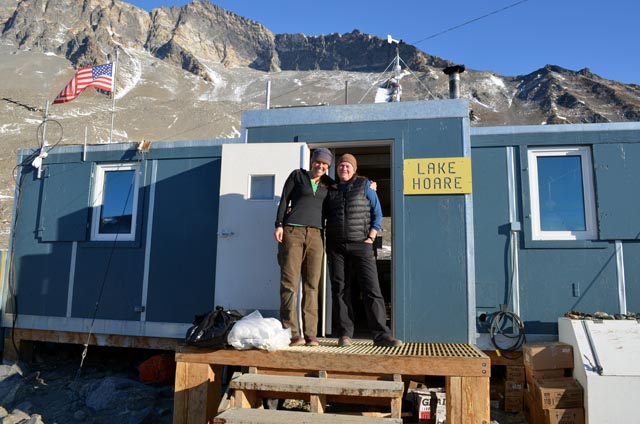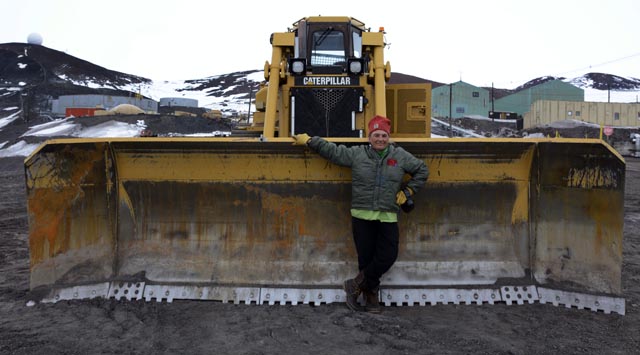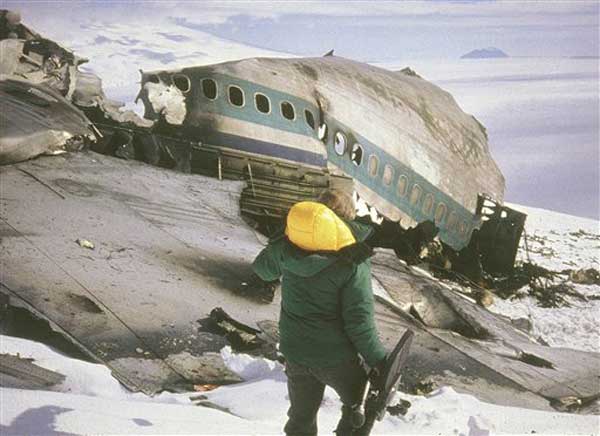
Photo Credit: Jim Mastro
|
Rae Spain, right, is now in her 18th year as the Lake Hoare camp manager after first coming to
Antarctica in 1979 to work in the carpenter shop.
|
Page 2/2 - Posted December 12, 2014
McMurdo was a 'bit of a frontier town' back in 1979
For the most part, civilians were involved in doing construction and directly supporting scientists, usually referred to as grantees, while Naval Support Force Antarctica (NSFA) personnel were more concerned with operations. They kept the station going by running the power plant (Penguin Power and Light – Bldg. 136), water distillation (on Observation Hill – now demolished), the galley, cargo (Terminal Operations – also demolished), medical, all aircraft activities, heavy equipment, and most other elements of the program infrastructure.
“It was a bit of a frontier town back then,” according to Rae, and there was “a lawlessness about it that was attractive.”
There were fewer rules. “People did what was right and sensible,” says Jules. “People were more relaxed.”
“It seemed like there was little you could do wrong,” Rob says. “Except cross-country ski. You were not allowed to cross-country ski.”
Today you’re allowed to cross-country ski, though they did things in 1979 that might raise eyebrows today. For instance, a man named Phil Colbert built a boat, which Rob converted into a sailboat in the winter of 1981 and sailed in front of McMurdo.

Photo Credit: Peter Rejcek
Julia “Jules” Uberuaga, like the other 1979 alumni, recalls McMurdo being a tightknit community.
There seemed to be an attitude on the part of H&N management that the work and the living arrangements constituted a hardship, so they wanted to do whatever they could, according to Jules, “to make this job as fun as it can be.” This started with the orientation in southern California, which took place at a big hotel with a giant pool and a catered barbecue. The attitude continued, at least a little, in McMurdo. Every year there was a flag-tying party in which everyone chipped in to tie red, green, and black flags to bamboo poles for the purpose of marking roads and hazards on the sea ice. H&N provided the food and refreshments.
Obviously, things are somewhat different now. In today’s NSF-managed program, the military’s role, while still vital, is greatly reduced. There are no more flag-tying parties or extravagant stateside orientations. And there are a lot more women – about 30 percent of the population this year. “That’s much better,” Rae says.
All four alumni pointed out that the environmental situation is much improved, too. Garbage used to be bulldozed into Winter Quarters Bay or openly burned in the Fortress Rocks dump. Raw sewage went directly into McMurdo Sound. No more. “It’s wonderful how we’ve cleaned up our act,” Rick says.
Not all of the changes have necessarily been good ones, though, at least from a veteran’s personal perspective. “It was more of a tightknit community [in 1979],” Rob points out.
“It was a community because it had to be a community,” Rick explains. Since communication back to the states and to corporate headquarters was limited and sometimes nonexistent, “everything was focused here. Whatever happened, we had to deal with it here, with the boots on the ground.” That made for a lot more social interaction. “It was more spontaneous, but now it’s more structured. People tend to stick to cliques. It’s a different energy.”
He blames some of that on the Internet and on the instant communication taken for granted today. For all the obvious benefits of that communication, it has diluted the feeling of community, according to Rick, the feeling that we’re on our own and all in this together. The outside world has intruded, demolishing that former isolation.

Photo Credit: Archives New Zealand
The crash of that Air New Zealand DC-10 tourist flight into Mount Erebus was perhaps the single, biggest defining incident of 1979.
Jules recalls how people had to make a reservation two weeks in advance in order to call home through the satellite phone system at Scott Base, the New Zealand research station located two miles from McMurdo. Then they had to hope someone would be home. These days, everyone has a phone in his or her room. “McMurdo is just a microcosm of what’s going on elsewhere,” she says.
Talking about how things used to be was unexpectedly emotional for some. This was especially true when the subject of conversation was Flight 901.
The crash of that Air New Zealand DC-10 tourist flight into Mount Erebus was perhaps the single, biggest defining incident of 1979. It was the very first thing that came to everyone’s mind. The tragedy, which killed all 257 people aboard, cast a pall over the entire program for weeks, and its effects linger even today in the minds of those who were there as well as in the New Zealand national consciousness. Tears came to the eyes of some McMurdo old-timers as they recalled the tragedy.
When it was announced that the wreckage of the aircraft had been located and there were no survivors, Jules recalls, “It was a chilling moment.”
Another tragedy, smaller but no less hurtful to the civilian community, occurred at South Pole when Casey Jones, a friend of Jules and Rob, was killed by falling ice.
For all four of these long-time Antarcticans, 1979 was a time of great change, a time when possibilities seemed limitless on a new and somewhat wild frontier, while at the same time the fragility of life became all too clear.
Previous
1
2
Next







